The Intel 6th Gen Skylake Review: Core i7-6700K and i5-6600K Tested
by Ian Cutress on August 5, 2015 8:00 AM ESTGenerational Tests on the i7-6700K: Gaming Benchmarks on Mid-Range GPUs
Alien: Isolation
If first person survival mixed with horror is your sort of thing, then Alien: Isolation, based off of the Alien franchise, should be an interesting title. Developed by The Creative Assembly and released in October 2014, Alien: Isolation has won numerous awards from Game Of The Year to several top 10s/25s and Best Horror titles, ratcheting up over a million sales by February 2015. Alien: Isolation uses a custom built engine which includes dynamic sound effects and should be fully multi-core enabled.
For low end graphics, we test at 720p with Ultra settings, whereas for mid and high range graphics we bump this up to 1080p, taking the average frame rate as our marker with a scripted version of the built-in benchmark.
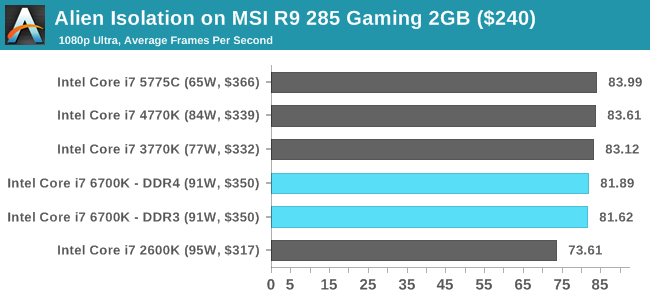
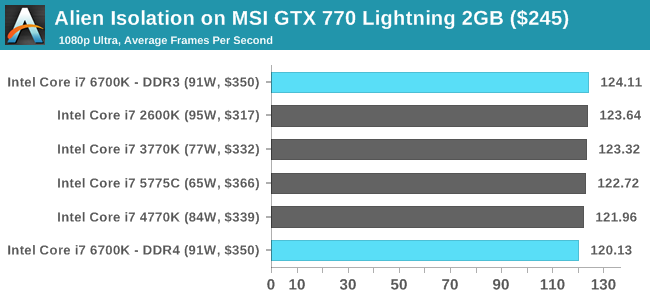
Total War: Attila
The Total War franchise moves on to Attila, another The Creative Assembly development, and is a stand-alone strategy title set in 395AD where the main story line lets the gamer take control of the leader of the Huns in order to conquer parts of the world. Graphically the game can render hundreds/thousands of units on screen at once, all with their individual actions and can put some of the big cards to task.
For low end graphics, we test at 720p with performance settings, recording the average frame rate. With mid and high range graphics, we test at 1080p with the quality setting. In both circumstances, unlimited video memory is enabled and the in-game scripted benchmark is used.
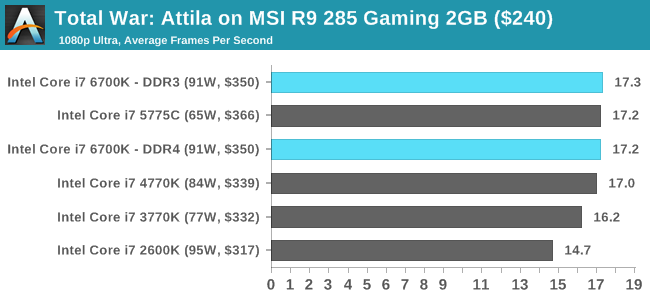
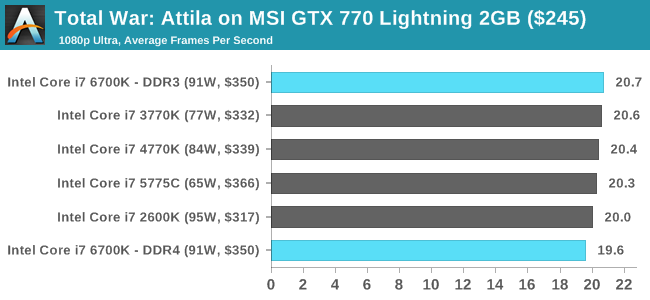
Grand Theft Auto V
The highly anticipated iteration of the Grand Theft Auto franchise finally hit the shelves on April 14th 2015, with both AMD and NVIDIA in tow to help optimize the title. GTA doesn’t provide graphical presets, but opens up the options to users and extends the boundaries by pushing even the hardest systems to the limit using Rockstar’s Advanced Game Engine. Whether the user is flying high in the mountains with long draw distances or dealing with assorted trash in the city, when cranked up to maximum it creates stunning visuals but hard work for both the CPU and the GPU.
For our test we have scripted a version of the in-game benchmark, relying only on the final part which combines a flight scene along with an in-city drive-by followed by a tanker explosion. For low end systems we test at 720p on the lowest settings, whereas mid and high end graphics play at 1080p with very high settings across the board. We record both the average frame rate and the percentage of frames under 60 FPS (16.6ms).
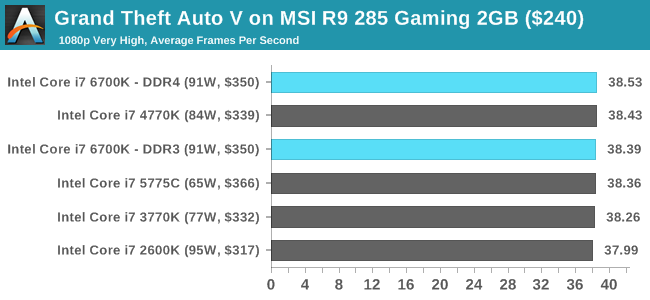
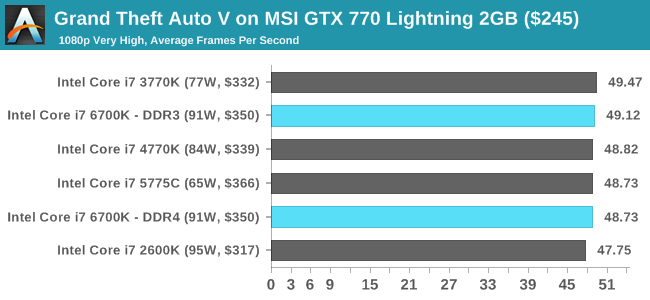
GRID: Autosport
No graphics tests are complete without some input from Codemasters and the EGO engine, which means for this round of testing we point towards GRID: Autosport, the next iteration in the GRID and racing genre. As with our previous racing testing, each update to the engine aims to add in effects, reflections, detail and realism, with Codemasters making ‘authenticity’ a main focal point for this version.
GRID’s benchmark mode is very flexible, and as a result we created a test race using a shortened version of the Red Bull Ring with twelve cars doing two laps. The car is focus starts last and is quite fast, but usually finishes second or third. For low end graphics we test at 1080p medium settings, whereas mid and high end graphics get the full 1080p maximum. Both the average and minimum frame rates are recorded.
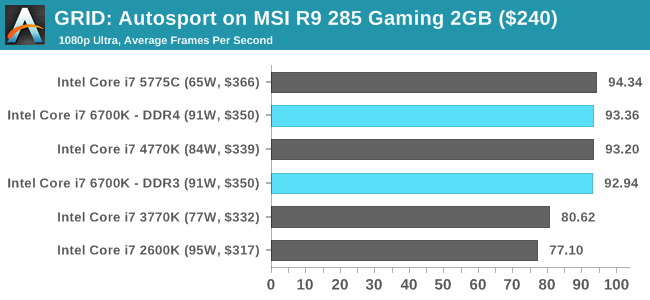
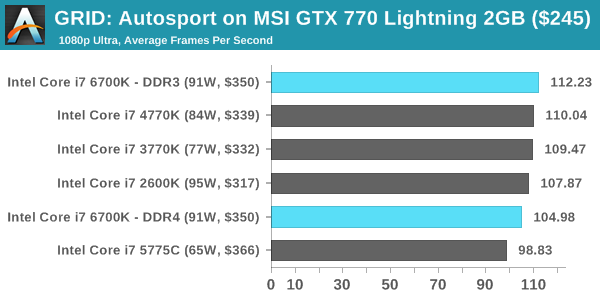
Middle-Earth: Shadow of Mordor
The final title in our testing is another battle of system performance with the open world action-adventure title, Shadow of Mordor. Produced by Monolith using the LithTech Jupiter EX engine and numerous detail add-ons, SoM goes for detail and complexity to a large extent, despite having to be cut down from the original plans. The main story itself was written by the same writer as Red Dead Redemption, and it received Zero Punctuation’s Game of The Year in 2014.
For testing purposes, SoM gives a dynamic screen resolution setting, allowing us to render at high resolutions that are then scaled down to the monitor. As a result, we get several tests using the in-game benchmark. For low end graphics we examine at 720p with low settings, whereas mid and high end graphics get 1080p Ultra. The top graphics test is also redone at 3840x2160, also with Ultra settings, and we also test two cards at 4K where possible.
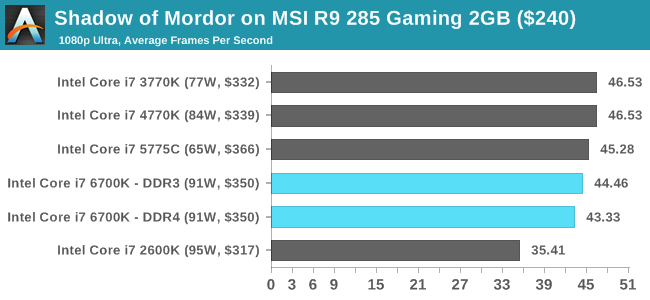
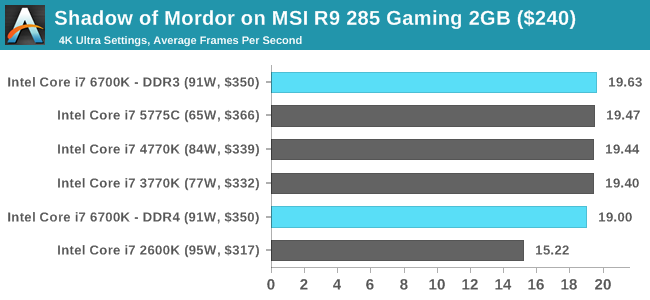

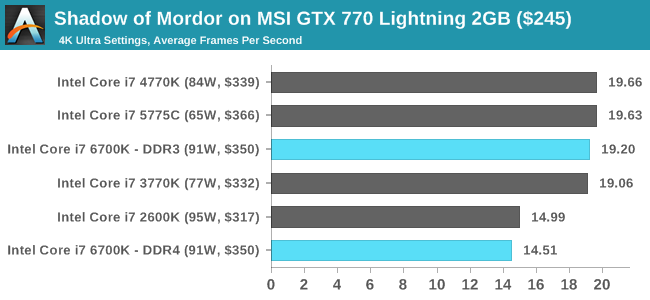















477 Comments
View All Comments
Jaguar36 - Wednesday, August 5, 2015 - link
I still don't see the point in upgrading from Sandybridge let alone anything newer. Its a big chunk of a cash for a new mobo, CPU and memory, all for what, 25%?Cumulus7 - Wednesday, August 5, 2015 - link
Exactly.Usually i suggest an upgrade if you get approximately twice the performance (+100%). But for 25%: forget it! Never!!!
colonelclaw - Wednesday, August 5, 2015 - link
The other way of looking at it is that it's amazing how good the Sandy Bridge numbers hold up, that good ol' 2600k is one of Intel's all-time great CPUs. Be happy you backed a winner!mrcaffeinex - Wednesday, August 5, 2015 - link
I did and I am very happy. It frees up funds to focus on other parts that make a bigger impact like more RAM, a larger SSD, and of course a better video card.This is better than Haswell in several ways and I imagine the overclockers are going to have some fun since they have been given back more options than some of the previous generations. At least it looks like Intel is paying more attention to the enthusiasts this time around, even if they are not the largest target market.
Cellar Door - Thursday, August 6, 2015 - link
Well, I'm glad I held back on the 2600K and 3770K and got haswell!! - So with this kind of reasoning, its a never ending circle.Look at the platform overall, the pcix storage, nvme compatibility, m.2 ports. USB 3.1 which will be all over the place a lot faster then people realize.
At the same speed its 37% faster and "In specific tests, it is even higher" - a good clocking 6700K will be a nice upgrade for anyone with Sandy. Just like Haswell was for Nahelem users.
Seems a perfectly justifiable upgrade.
Kutark - Sunday, August 9, 2015 - link
Eh. I've been wanting an excuse to upgrade from my 2600k. I am an "enthusiast" and building PC's and such is my hobby. So, it's not always just simply the price/perf value proposition. Christmas is coming up and my nephew doesn't have his own PC yet, and also loves to play steam games (he usually does it at his grandparents). So, this gives me an excuse to build a new setup. I still have my GTX 760 laying around that i upgraded to a 980ti. So a 6700k setup would be a nice pairing with the 980ti and should realistically set me for 3-4 years.kmmatney - Wednesday, August 5, 2015 - link
I'm an i5 3570K owner. If I'm going to upgrade, I'd look for an i7-4790K (or even a i7 2600K) on Ebay before completely overhauling my system with this.darkfalz - Wednesday, August 5, 2015 - link
Even that's a waste of money unless you are doing a tonne of Handbrake.mapesdhs - Wednesday, August 12, 2015 - link
No, get a 2700K instead, they oc much better than the 2600K.2700K = 5GHz guaranteed, even with a simple TRUE and one fan (I use the ASUS M4E,
built five so far).
tim851 - Wednesday, August 5, 2015 - link
Agreed. Especially when you factor in that those 25% is peak performance. How often does the average user call on peak performance? I think the most common and frequent scenario for average users to need CPU power is gaming. And here, due to the fact that GPUs are the bottleneck, you won't even get 10%.From an enthusiast point of view, the last 4 years since Sandy Bridge have been disappointing. If not outright worrying.